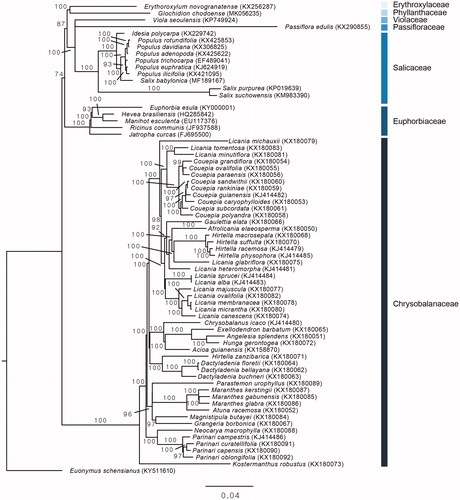Abstract
The complete chloroplast genome sequence of Glochidion chodoense, an endemic species to Korea, was determined by Illumina pair-end sequencing. The complete cp genome was 157,085 bp in length, containing a large single copy (LSC) of 85,304 bp and a small single copy (SSC) of 17,635 bp, which were separated by a pair of 27,073 bp inverted repeats (IRs). A total of 111 unique genes were annotated, including 78 protein-coding genes, 29 tRNA genes, and 4 rRNA genes. Among these genes, 18 genes contained an intron. The ML tree showed that G. chodoense was most close to Erythoroxylum novogranatense with high support.
Genus Glochidion, belonging to Phyllanthaceae, include about 200 taxa and distributed chiefly in tropical regions of Asia and the Pacific islands (Lee and Im Citation1994). Among the Glochidion species, Glochidion chodoense is very important species due to Korean endemic and distributed only Jindo island of South Korea. According to these reasons, it is listed in the rare plant in Korea as a ‘Critically Endangered’ grade by IUCN category (Korea National Arboretum Citation2009). Therefore, we need to establish a strategy for conservation of G. chodoense. The complete chloroplast genome studies give lots of information about genetic diversity and evolution that are of great importance in the conservation genetics (Ye et al. Citation2014; Gao and Gao Citation2017).
In this study, we report and characterize the plastid genome of G. chodoense (GenBank accession no. MK056235) and this data will be used as important information for protection strategy of species and the study of genome diversity. The plant material was sampled from Nakdong-ri (Jindo-gun, Jeollanam-do province). The voucher specimen was deposited as Kangwon National University Herbarium (KWNU) and the voucher number is KWNU93462. Total DNA was extracted using a DNeasy Plant Mini Kit (Qiagen Inc., Valencia, CA, USA). Genomic DNA was used for sequencing by an Illumina Miseq (Illumina Inc., San Diego, CA, USA) platform. Glochidion chodoense was sequenced to produce 7,269,520 raw reads and 301 bp were obtained from them. The plastid genome assembly was performed by the de novo assembly protocol (Cho et al. Citation2015) via the Phyzen bioinformatics pipeline (http://phyzen.com). The annotation of the chloroplast genome was based on the online available program: DOGMA (Wyman et al. Citation2004), coupled with manual corrections for start and stop codons. We also compared each gene to the published complete chloroplast genome sequence of Euphorbiaceae and Erythroxylaceae for correct gene annotation. The tRNAs were confirmed using tRNAscan-SE (Schattner et al. Citation2005). A circular plastid genome map was drawn using the OGDRAW program (Lohse et al. Citation2007).
The complete chloroplast genome of G. chodoense is circular DNA molecule of 157,085 bp in length with 36.7% G + C content and composed of large single copy (LSC) region of 85,304 bp, small single copy (SSC) region of 17,635 bp, and two inverted repeats (IR) regions of 27,073 bp. The plastid genome contains a total of 111 unique genes constituting 78 protein-coding genes, 29 transfer RNA (tRNA) genes, and 4 ribosomal RNA (rRNA) genes. Among the 111 unique genes, eighteen genes (atpF, clpP, ndhA, ndhB, petB, petD, rpl2, rpl16, rpoC1, rps12, rps16, ycf3, trnA-UGC, trnG-UCC, trnI-GAU, trnK-UUU, trnL-UAA, trnV-UAC) contained one or two introns. The rps12 gene is a trans-spliced gene with a 5′ end exon in the LSC region and two duplicated 3′ end exons in the IR regions.
To construct the phylogenetic tree (), a total of 65 protein-coding genes of 69 Malpighiales species and one outgroup (Euonymus schensianus) were aligned with MAFFT (Katoh et al. Citation2002). Also, we conducted maximum likelihood (ML) analysis using RAxML v.7.4.2 with 1000 bootstrap replicates and GTR + I model (Stamatakis Citation2006). The ML tree formed clearly divided into two clades with the family level. Also, G. chodoense was most closely related to Erythoroxylum novogranatense (Erythroxylaceae) with high support (BS = 100).
Disclosure statement
The authors report no conflicts of interest. The authors alone are responsible for the content and writing of the paper.
Additional information
Funding
References
- Cho KS, Yun BK, Yoon YH, Hong SY, Mekapogu M, Kim KH, Yang TJ. 2015. Complete chloroplast genome sequence of tartary buckwheat (Fagopyrum tataricum) and comparative analysis with common buckwheat (F. esculentum). PLoS One. 10:e012533.
- Gao CW, Gao LZ. 2017. The complete chloroplast genome sequence of semi-wild soybean, Glycine gracilis (Fabales: Fabaceae). Conservation Genet Resour. 9:343–345.
- Katoh K, Misawa K, Kuma K, Miyata T. 2002. MAFFT: a novel method for rapid multiple sequence alignment based on fast Fourier transform. Nucleic Acids Res. 30:3059–3066.
- Korea National Arboretum. 2009. Rare plants data book in Korea. Pocheon: Korea National Arboretum.
- Lee CS, Im HT. 1994. Glochidion chodoense C.Lee et Im (Euphorbiaceae), a new species from Chodo Archipelago, Korea. Korean J. Plant Taxon. 24:13–16.
- Lohse M, Drechsel O, Bock R. 2007. OrganellarGenomeDRAW (OGDRAW): a tool for the easy generation of high-quality custom graphical maps of plastid and mitochondrial genomes. Curr Genet. 52:267–274.
- Schattner P, Brooks AN, Lowe TM. 2005. The tRNAscan-SE, snoscan and snoGPS web servers for the detection of tRNAs and snoRNAs. Nucleic Acids Res. 33:W686–W689.
- Stamatakis A. 2006. RAxML-VI-HPC: maximum likelihood-based phylogenetic analyses with thousands of taxa and mixed models. Bioinformatics. 22:2688–2690.
- Wyman SK, Jansen RK, Boore JL. 2004. Automatic annotation of organellar genomes with DOGMA. Bioinformatics. 20:3252–3255.
- Ye C-Y, Lin Z, Li G, Wang Y-Y, Qiu J, Fu F, Zhang H, Chen L, Ye S, Song W, et al. 2014. Echinochloa chloroplast genomes: insights into the evolution and taxonomic identification of two weedy species. PLoS One. 9:e113657.

